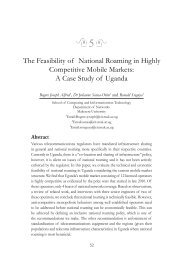Undergraduate Handbook - School of Computing and Informatics ...
Undergraduate Handbook - School of Computing and Informatics ...
Undergraduate Handbook - School of Computing and Informatics ...
You also want an ePaper? Increase the reach of your titles
YUMPU automatically turns print PDFs into web optimized ePapers that Google loves.
algebra, canonical forms, Karnaugh maps, combinational network analysis <strong>and</strong> design, MSI modules. Sequential<br />
logic: latch, flip-flop <strong>and</strong> logic design, state diagram, sequential network analysis <strong>and</strong> synthesis, register, counter,<br />
memory organization.<br />
Reference Books:<br />
i. L.S. Bobrow, <strong>and</strong> M. A. Arbib, Discrete Mathematics: Applied Algebra for Computer <strong>and</strong> Information<br />
Science, Philadelphia, PA: Saunders, 1974.<br />
ii. J. A, Dossey, A, D, Otto, L. Spence, <strong>and</strong> C. V. Eynden, Discrete Mathematics, 3rd edition. Reading, MA:<br />
Addison-Wesley, 1997.<br />
iii. K. Balakrishnan, Introductory Discrete Mathematics, New York: Dover, 1997.<br />
BSE 1105: Business Law (3 CU)<br />
Course Description: Upon successful completion <strong>of</strong> this course, the student will: Underst<strong>and</strong> the basic nature <strong>of</strong> the<br />
legal system including the court structure <strong>and</strong> the role <strong>of</strong> lawyers; Underst<strong>and</strong> the different types <strong>of</strong> torts <strong>and</strong> crimes;<br />
Be familiar with contract law including all the elements <strong>of</strong> a contract under the common law as well as the Uniform<br />
Commercial Code; Underst<strong>and</strong> the basic theories <strong>of</strong> products liability law; Be familiar with the creation <strong>of</strong> security<br />
interests <strong>and</strong> the rules that secured creditors must follow; Underst<strong>and</strong> the basic features <strong>of</strong> bankruptcy law;<br />
Underst<strong>and</strong> the general nature <strong>of</strong> an agency relationship<br />
Indicative Content: This subject acquaints the student with legal concepts <strong>and</strong> their application to business <strong>and</strong><br />
personal situations. Attention is paid to problems arising under the following topical headings: basic nature <strong>of</strong> the<br />
legal system; tort law; contract law, including both common law principles <strong>and</strong> the provisions <strong>of</strong> the Uniform<br />
Commercial Code; products liability law; debtor/creditor relations; bankruptcy law; <strong>and</strong> agency law. Introduction to<br />
Legal System; Tort <strong>and</strong> Criminal law; Contract Law; Uniform Commercial Code; Products Liability Law; Secured<br />
Transactions; Bankruptcy; Agency.<br />
Reference Books:<br />
i. Ibp Usa <strong>and</strong> Emerging Markets Investment Center, Ug<strong>and</strong>a Business Law <strong>H<strong>and</strong>book</strong>, International<br />
Business Publications, USA; 2nd edition, 1999.<br />
BSE 1200: Principles <strong>of</strong> S<strong>of</strong>tware Development I (4 CU)<br />
Course Description: Upon successful completion, the student should be able to: Demonstrate mastery <strong>of</strong> the<br />
s<strong>of</strong>tware development process, describing core activities at various levels <strong>of</strong> s<strong>of</strong>tware development; Perform<br />
requirement analysis <strong>of</strong> a simple s<strong>of</strong>tware systems; Manage a team <strong>of</strong> developers; Demonstrate knowledge <strong>of</strong> at<br />
least one tool <strong>of</strong> s<strong>of</strong>tware documentation; Work in a team; <strong>and</strong> design, develop, test <strong>and</strong> valid a s<strong>of</strong>tware product.<br />
Indicative Content: Introduction: What is s<strong>of</strong>tware engineering? Phases in the development <strong>of</strong> s<strong>of</strong>tware; S<strong>of</strong>tware<br />
Management: Planning <strong>and</strong> controlling a s<strong>of</strong>tware development project. Requirements analysis: Requirements<br />
specification, humans as information sources, tools for documenting the requirements (SADT, PSL/PSA, Ada-based<br />
analysis methods). S<strong>of</strong>tware design: Abstraction, modularity, information hiding, design methods, design<br />
documentation; Testing: Test objectives, verification <strong>and</strong> validation, manual test techniques, techniques for<br />
functional <strong>and</strong> structural testing.<br />
Reference Books:<br />
i. B. Boehm <strong>and</strong> R. Turner, Balancing Agility <strong>and</strong> Discipline: A Guide for the Perplexed, Addison Wesley<br />
Pr<strong>of</strong>essional, 2003.<br />
ii. A. M. Davis, 201 Principles <strong>of</strong> S<strong>of</strong>tware Development, McGraw-Hill, March, 1995.<br />
BSE 1201: Numerical Analysis (4 CU)<br />
Course Description: Upon completion <strong>of</strong> the course, the student should be able to: Demonstrate factual knowledge<br />
including the mathematical notation <strong>and</strong> terminology used in the course; Describe the fundamental principles<br />
including the laws <strong>and</strong> theorems arising from the concepts covered in this course; Apply course material along with<br />
107

















